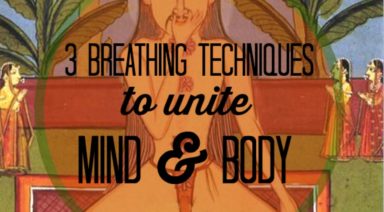5 Tips to Get you Started on a Daily Meditation Practice

- Plan ahead
A good time to meditate is right after you wake up, before your mind is busy with thoughts and activities of the day. If you normally feel sluggish in the morning, take a look at your nighttime routine. Ayurveda, the 5,000 year old healing system of India, suggests following nature’s rhythm, e.g. waking at sunrise and quieting down at sunset. Try getting a good 6-8 hours of sleep each night and avoid stimulating food, conversation and activities prior to sleep. Even though sitting in front of the TV or computer, may sound relaxing, the bright light produced by TV’s and computers can disrupt a good night’s sleep.
- Wake up 15 minutes earlier
If you use an alarm, choose a quiet setting for the ringer and place it further away from your nightstand. Let yourself slowly wake up rather than jarring your sympathetic nervous system, commonly referred to as the “fight or flight” response. Try to wake yourself up as you would a newborn baby.
- Find a comfortable, quiet place to sit
Choose a place in your home that you can dedicate as your “seat.” This can be on a cushion on the floor or if that’s uncomfortable, find a chair where you can sit upright and place both feet on the floor. Try to keep your spine erect so that your breath and energy can flow freely. It’s also healthier for your back.
- Start with breath awareness
Take a couple of minutes to bring your awareness to your breath. Inhale deeply and exhale completely, releasing any tension in your body. If you are meditating in the afternoon, try to let go of the events of the day and bring your attention to the present moment.
- Use a mantra
The word mantra means instrument or vehicle of the mind. A mantra is a tool to help quiet your mind first prior to experiencing moments of silence. You can receive a personal mantra from a meditation teacher or to help you get started, use a simple mantra of “1, 2.” As you inhale, silently repeat “1” and as you exhale, silently repeat “2.” Inhale “1,” exhale “2,” and keep repeating. When you notice that your awareness has drifted off to thoughts, gently bring it back to the repetition of “1, 2.” Be easy on yourself and try not to judge your meditation. Trust that the benefits of a daily meditation practice are present to you and those around you in your interaction with others.
Which Type of Meditation Style is Best For You?

While some may think that meditation requires nothing more than sitting silently, it isn’t necessarily as easy as it seems. The commitment needed to practice every day coupled with the challenge to empty your mind of everyday stressors can be discouraging. However, it doesn’t necessarily need to be.
Meditation has been scientifically proven to reduce stress and anxiety, improve health, and increase happiness. However, the most essential aspect of meditation is appealing to your spirit. It is an entirely subjective practice and there is no right or wrong way to meditate. By practicing every day and finding a style that compliments your soul – you’ll not only experience the joy in meditation, but you might just find you’re better at it then you thought!
The following is a list of the most common types of meditation. Discover which one speaks to you!
Types of Meditation
The following are the most common types of meditation styles. Before you begin, ask yourself a few questions:
- Do you find increased focus through movement?
- Does darkness help you to relax?
- Do you find sounds calming or distracting?
- Are you trying to focus your mind or empty it?
Answering these simple questions can help you to narrow down which type of meditation is most suited for you. If by the end of this article you still can’t decide – Why not try them all?
































